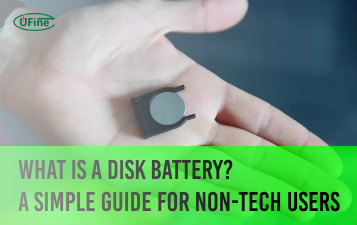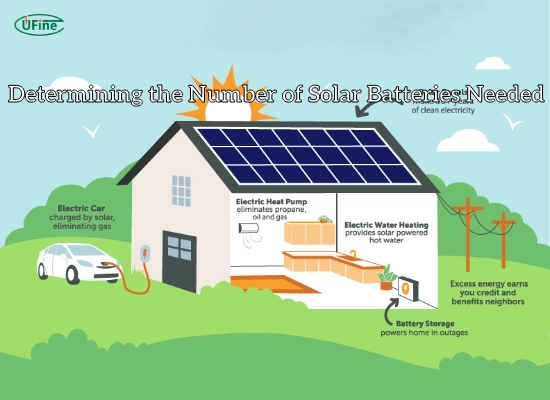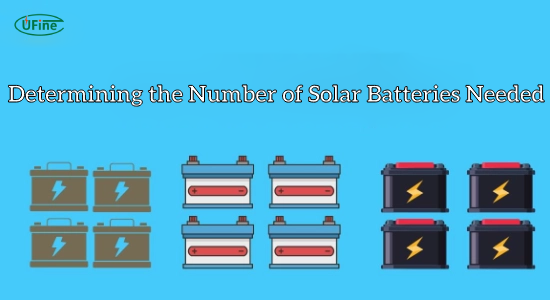How many solar batteries are needed to power a house? This is a common question for homeowners considering a transition to solar energy. With the increasing push towards renewable energy, understanding the intricacies of solar batteries is crucial. This article will delve into the factors determining the number of solar batteries required, offering a comprehensive guide to help you make an informed decision.
Part 1. Understanding solar batteries
Solar batteries are essential components of a solar power system. They store the energy generated by solar panels for use during periods when the panels are not producing electricity, such as at night or during cloudy weather. Here’s a deeper look into how they work and their types:
How do solar batteries work?
Solar panels convert sunlight into direct current (DC) electricity. This electricity is used immediately by your home, sent to the grid, or stored in solar batteries for later use. When the stored energy is needed, the batteries discharge electricity, which an inverter converts into the alternating current (AC) used by most household appliances.
Types of solar batteries
There are several types of solar batteries, each with its advantages and disadvantages:
- Lead-acid batteries: These are the oldest type of rechargeable battery and are relatively inexpensive. However, they have a shorter lifespan and lower discharge depth (DoD) than other types.
- Lithium-ion batteries are more expensive but offer a longer lifespan, higher efficiency, and greater DoD. They are becoming the preferred choice for many residential solar power systems.
- Saltwater batteries: A newer technology, these are more environmentally friendly as they do not contain heavy metals. However, they are less common and more expensive.
Key features to consider
When choosing solar batteries, consider the following features:
- Capacity: Measured in kilowatt-hours (kWh), this indicates how much energy the battery can store.
- Power: Measured in kilowatts (kW), this indicates how much energy the battery can simultaneously deliver.
- Depth of Discharge (DoD): This indicates the percentage of the battery’s capacity that users can use without damaging it.
- Efficiency: The percentage of energy that can be stored and retrieved from the battery.
Part 2. Determining the number of solar batteries needed
We must consider a combination of factors to determine how many solar batteries are required to power a house. These include your household’s energy consumption, the batteries’ capacity, and the solar panels’ efficiency. Let’s break this down:
1. Calculating energy consumption
Understanding your household’s energy needs is the first step. Here’s how you can do it:
- Review electricity bills: Look at your past electricity bills to find your average monthly kilowatt-hours (kWh) usage.
- Daily usage estimate: Divide your monthly usage by 30 to get a daily estimate.
- Energy audit: Conduct an energy audit to identify major energy-consuming appliances and their usage patterns.
2. Battery capacity and number
Once you have your daily energy consumption, you can determine the battery capacity required. For example, if your household uses 30 kWh per day:
- Daily energy requirement: 30 kWh.
- Battery capacity: If each battery has a capacity of 10 kWh, you would need 30 kWh / 10 kWh per battery = 3 batteries to store one day’s energy.
3. Solar panel efficiency and sunlight availability
The efficiency of your solar panels and the amount of sunlight your location receives also play crucial roles. Higher-efficiency panels generate more electricity, potentially reducing the number of batteries needed. Similarly, areas with more sunlight will produce more energy, which affects storage requirements.
4. System efficiency and losses
Energy losses can occur during conversion and storage. High-quality components and proper installation can minimize these losses, ensuring your system operates efficiently.
Example calculation
Let’s say your household uses 30 kWh per day, and you have chosen batteries with a capacity of 10 kWh each:
- Daily energy requirement: 30 kWh.
- Battery capacity: 10 kWh per battery.
- Number of batteries needed: 30 kWh / 10 kWh = 3 batteries.
This is a simplified example. You should also consider reserve capacity for cloudy days and potential system inefficiencies.
Part 3. Additional considerations for solar battery systems
When planning your solar battery system, there are several additional factors to consider:
Battery lifespan and maintenance
Solar batteries typically last between 5 to 15 years. Regular maintenance can extend their lifespan by checking charge levels and ensuring proper ventilation. It’s also essential to follow the manufacturer’s maintenance guidelines.
Cost and investment
The initial cost of solar batteries can be high. Still, they offer long-term savings on electricity bills and increased energy independence. When calculating the return on investment, consider the upfront costs and potential savings over the batteries’ lifespan.
Scalability and future expansion
Consider the scalability of your system. As your energy needs grow, you should add more batteries. Choose a system that allows for easy expansion.
Environmental impact
Using solar batteries reduces your carbon footprint by decreasing reliance on fossil fuels. Additionally, many solar batteries are recyclable, further minimizing environmental impact.
Part 4. FAQs
-
How long do solar batteries last?
Solar batteries typically last 5 to 15 years, depending on the type and usage. Lithium-ion batteries tend to have a longer lifespan compared to lead-acid batteries. -
Can I use solar batteries during a power outage?
Solar batteries can provide backup power during outages, ensuring that essential appliances and systems remain operational. -
Are solar batteries worth the investment?
While the initial cost can be high, solar batteries can lead to long-term savings on electricity bills and provide energy security, making them a worthwhile investment for many homeowners. -
How do I maintain solar batteries?
Regular maintenance includes checking the battery charge levels, ensuring proper ventilation, and monitoring for any signs of wear or damage. Follow the manufacturer’s guidelines for specific maintenance requirements. -
Can solar batteries be recycled?
Yes, most solar batteries are recyclable. It’s essential to dispose of them properly at the end of their lifespan to minimize environmental impact.
Related Tags:
More Articles

What Is a Disk Battery? A Simple Guide for Non-Tech Users
A disk battery is a small, round cell used in watches, remotes, and other electronic devices. It delivers steady power for compact, low-drain devices.
What Battery Powers a Space Heater?
Discover the type of battery that powers space heaters and learn how to choose the right one for efficient heating in your home or office.
What Is an LR14 Battery? Learn About This C-Size Cell
The LR14 battery, also known as a C battery, delivers steady power. Learn its specs, uses, lifespan, and how it compares to other battery types.
Watch Battery Dimensions Chart: Sizes, Voltages, and Equivalents Explained
Understanding watch battery dimensions helps you choose the right size, voltage, and equivalent model to keep your watch running safely and smoothly.
How Long Can You Rely on Battery-Powered Generators?
Discover battery generator runtime & lifespan factors. Learn how to maximize performance and choose the right power solution.





